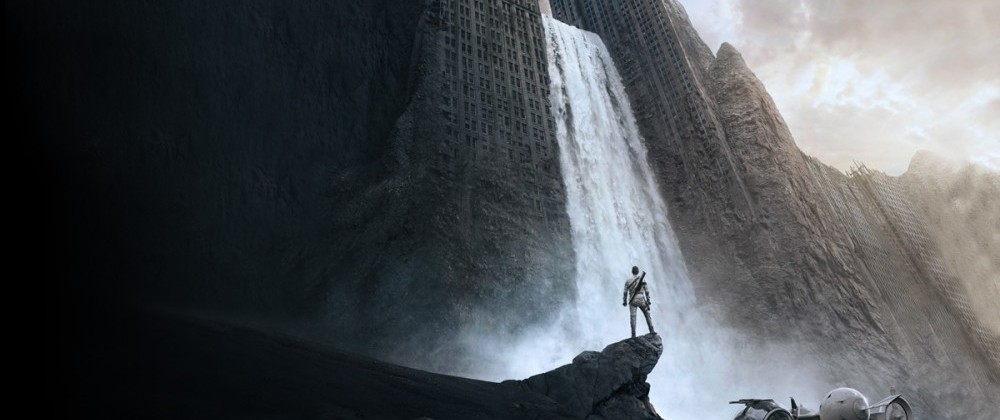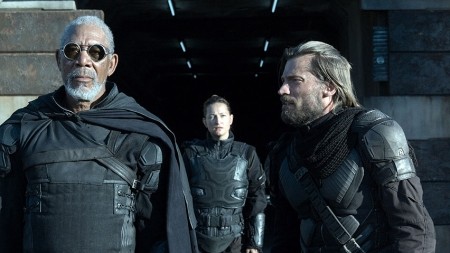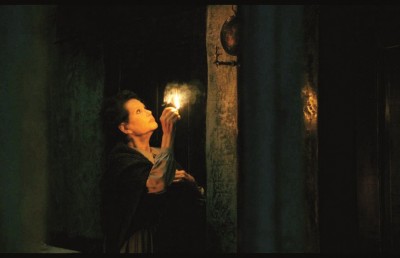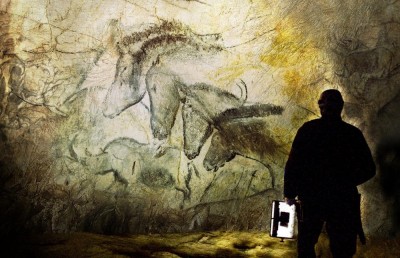Oblivion: Trouble with Cinematic Memory

Two things struck me in the first hour of Universal’s recent blockbuster Oblivion: The familiarity of its elements (at times iconic, at others cliché) and the degree of physicality in so thoroughly digital a production. The first of these I was prompted for, by reviews that cited a derivative spirit in the film with few citing exactly what its screenplay was deriving from, or explaining why the makers of Oblivion – or any film, for that matter – should be faulted for the practice. The second aspect was harder to put my finger on; so much has changed – and in ways improved – in VFX in these first years of digital’s victory over photo-chemical film. (To offer just one example of this Pyrrhic victory, last year the number of digitally-projecting venues would for the first time exceed 35mm-only venues.) Was the sense of physicality ‘just me’, or was it also in the product, as a document of actual, and not merely (i.e., excessively) computer generated events? This sense of substantive record in the film does indeed concern its staging. More significantly, it also concerns the two marriages of the film: the superficially genuine, fundamentally phony one of soldier-laborer Jack Harper (Cruise) with the more clerical half of his “effective team,” Victoria (Andrea Riseborough), and his diegetically genuine, yet distractingly cosmetic marriage to a Russian astronaut by the name of Ruskova.
Exquisitely shot on the Cinealta F46 and Red Epic, Oblivion is one of the more visually arresting contributions to its genre, largely due to its reliance on natural light and exteriors. Even key interior scenes often feature exterior visuals against which actors perform in real time, and objects with reflective surfaces (numerous here) are shot without concern. Instead of employing green screen for the film’s sky-high, glass house scenes, the F46’s mechanical shutter allowed for flicker-free front projection of clouds, stars, etc. These sky-scapes were shot by a second unit atop Mauna Kea “for two or three weeks,” 1 at different hours and weather conditions. Selected footage was fed to 21 projectors aimed away from the action at a wall/screen –over 23,000 square feet of painted muslin, bright and reflective enough to produce 95% of the necessary light for the action– producing a naturalism that eludes the most sophisticated chromakey strategies. As cinematographer Claudio Miranda explains about these extraordinary interior scenes:
The idea of going for 21 projectors to make this work was scary enough. But it was something special. You’re in that set and you could change the lighting anytime. You just call up a certain scene. You have a sunrise and you could put the sunrise on the left side, right side, anywhere you wanted. You could rotate the whole image around. You could move clouds if you wanted more on one side, or put them on the other side for a reflection somewhere else. And I could light with it, too. I could make a little hotspot on the top [outside the house’s visible window frame] and have light pour in. It was very amazing to be in this glass world without a reflection problem. 2
The cinematography also exploits Iceland’s steely terrain and unusually long magic hour (from 6pm-1am, due to the island’s northern position), yielding an embarrassment of landscape riches. It is primarily for this reason of exceptional staging and location – and despite occasionally rushed CGI – that it compares favorably with forebears The Quiet Earth (d. Geoff Murphy, 1984), Robinson Crusoe on Mars (d. Byron Haskin, 1964), The Omega Man (d. Boris Segal, 1971), Planet of the Apes (d. Franklin J. Schaffner, 1968), 2001: A Space Odyssey (d. Stanley Kubrick, 1968), Solaris (d. Andrei Tarkovsky, 1972), Zardoz (d. John Boorman, 1974), Demon Seed (d. Donald Cammell, 1977), Capricorn One (Peter Hyams, 1978), and Moon (d. Duncan Jones, 2009), as it claims little conceptual innovation. This is not necessarily a strike against the film –a characteristic of genre filmmaking is after all the repetition of form and theme– but it does command attention and perhaps a bit of research, and in this the many negative reviews, claiming weak writing, are remiss, and somewhat misleading. Excessive recourse to the grounding device (e.g., the dashboard bobble-head); exceedingly long action sequences (i.e., better suited to an action film, which this is not); the tired boomerism of Procol Harum’s “A Whiter Shade of Pale”; the lithe, supermodel wife (former supermodel Olga Kurylenko, now the vaguely exotic/Eastern love interest of several films, including this one); Morgan Freeman as the go-to black elder statesman; the pat homecoming… The easy choices of the production are many, but their essential error of familiarity (i.e., convention) at the expense of internal realism is perhaps mistaken for something native to the film’s achievement, precisely because it effectively combines so many now familiar sources. A patchwork of perennial science-fiction tropes (e.g., first contact, the lost civilization, the ascendant machine, simulacra & virtuality), Oblivion draws from each of the titles just cited in various ways, perhaps most obviously from the red-eyed computer/Cyclops of Kubrick’s 2001, though most heavily from Jones’ Moon, itself a sci-fi hybrid (its own sources 2001 and Solaris, as well as Silent Running, d. Douglas Trumball, 1972, Dark Star, d. John Carpenter, 1974, and some measure of his father’s ballad to Britain’s also-ran space program, “Space Oddity”). In another, more ironic parallel, Oblivion bears the title of a low budget space western from Charles Band’s straight-to-video schlockmill, Full Moon Entertainment. Shot in Romania, Oblivion (d. Sam Irvin, 1994) takes place in the small town of Oblivion, on a distant planet on the interstellar frontier (in a nod to the Western expansion premise George Takei is one of a handful of bargain celebrities), and pivots on the mining exploits of an alien tyrant called “Redeye.” The makers of the blockbuster Oblivion were likely aware of echoing the earlier title, but the reason this would not concern them, and the reasons they might claim obliviousness (alas) are interesting, as the original Oblivion is not only cheaply and shoddily produced, but woefully derivative, in a manner that makes the better conceived, funded, and mounted Oblivion appear inspired.

To return to the more substantial parallel, Moon centers on its protagonist’s isolation and ennui as a maintenance worker at a moon base established for the automated collection of helium-3. The isotope, being rare on Earth, is scooped and separated from the lunar ‘soil’ and shipped back for use in nuclear fusion (a combine-like machine trundling across the lunar landscape is one of several amusing and enduring images). On site for several years and nearing completion of his work contract, Sam Bell (Sam Rockwell), with only an artificial intelligence to keep him company (Kevin Spacey), is haunted by the memory of his wife, who he is unable to communicate with directly, and soon hallucinates that he sees a daughter he no longer knows, grown to adolescence. After an accident outside the base, Bell gradually discovers his manipulation/slavery by the nefarious Lunar Industries, the corporation that ostensibly employs him, but has in fact been cloning him and indefinitely forestalling the end of his contract and return to Earth, as harvesting of the helium-3 grinds on. In Oblivion, Jack Harper (Tom Cruise) services semi-autonomous equipment on a planet in ruin –an Earth he can apparently never come home to (n.b., his residence is virtually detached from Earth, hundreds of feet above its surface, and he is often seen in flight). The serviced equipment consists of security/surveillance drones and giant, tetrahedral machines that siphon seawater for fusion reactors off-world. We are told in voiceover that the state of the planet is due to the use of nuclear missiles, and to the moon having been deliberately compromised (causing catastrophic tsunamis) in a war with an alien race. The shattered moon –in pieces of various size, forming a scar-like swath in the sky– is visible, and we can believe this much of the backstory. However, unless the viewer is especially naïve about such films, the need for the protagonist’s memory to be erased (supposedly for security reasons), the role and/or existence of the alien race (that we never see), the benevolence of the narrator’s employer, and the nuclear component of the tale must all be taken as provisional. Haunted by a recurring dream of a woman he no longer knows, whom he eventually meets and discovers is his wife, Harper learns he has been enslaved by an alien technology that clones him indefinitely –along with what are apparently genetic memories of his marriage –exploiting his labor, and keeping him minimally satisfied in his work (primarily through the companionship of a false wife, also cloned), until the world’s oceans are drained.
While Bell forms a tenuous friendship with his cloned self and eventually returns to Earth, surreptitiously, to expose Lunar Industries, Harper raids the head office in grand Hollywood fashion (i.e., explosively), sacrificing himself for the species and allowing a cloned self on Earth to meet his true/past wife and new daughter (notwithstanding the many Harpers that presumably exist in now leaderless maintenance stations, haunted by the same genetic memories).
The protagonist’s distance from the home world –whether spatial or temporal– is linked to the moon’s earlier destruction in Oblivion, and off-world mining in Moon, but the causal connection between the two sci-fi conceits is plain. What makes this connection curious –and potentially problematic– is the differing scale of each production, as Moon was astronomically cheaper, costing a mere $5 million compared to Oblivion’s $120 million, suggesting a longstanding Hollywood tradition: throw enough money at a project, and its creative problem/s (in this case, clear derivation) are solved by an economics of scale. However, aside from its visuals –which reflect the film’s artistry at least as much as its generous budgeting– there are two fairly unique themes that save Oblivion from itself – from what we might call its indistinction. These are the hi-tech war, in which the all/any-American is complicit, and the conflict of the celluloid/cellular (i.e., live/living), and digital/electronic (i.e., virtual), beginning with the nostalgic opening image of the Empire State Building’s observation deck, a coin-operated pair of binoculars greeting us like an emissary of the medium on which it is shot –or appears to be shot. Though evident throughout the film due to the prominent role of lethal “drones” (in addition to ubiquitous surveillance, satellite mapping, heat-signature, and other video images and imaging of distant topography, figures, and events), the theme of telepresent war is clearest in the film’s second half, when the elusive, desert-dwelling enemy capture Harper, force him to recognize their humanity, and coerce him to program one of the captured drones to attack its origin (the orbiting artificial intelligence Harper unwittingly serves). The other theme is more profound but less apparent, giving the film a weight just beneath conscious detection: the tenuous relationship between a film past of material means – a past at risk of Oblivion, naturally represented by Cruise –and the current one of digital optimism, enfigured in the wife who dresses for work without leaving home (who in fact refuses to), and a CG rendering of a completed One World Trade Center, composited onto a healed New York, ripe for cataclysm and reified through the antiquated binoculars (n.b., from the deck of what was once the tallest skyscraper, and the first to suffer impact from an airplane). Blurred, but clearly the object of focus, an engagement ring is held up tentatively in the foreground, dwarfing the new tower. The form and tone of the essential conflict are perfectly united here. The trouble is in the proposition of such limited options for man and wife (not to mention viewer), when drawing from so vast a catalogue of futurist fiction. Ultimately, the nuclear family functions as a sort of punchline. Not a bad one, perhaps, but an exceedingly clean one –a choice, apparently, between Town and Country. Forget the ashes of your fathers and temples of your Gods, your cabin in the sky awaits. Or, if you prefer, the hidden valley of the LP.
Notes
- Jon Fauer, “Claudio Miranda, ASC on “Oblivion”,” Film and Digital Times, March 29th, 2013. ↩
- op. cit. ↩














